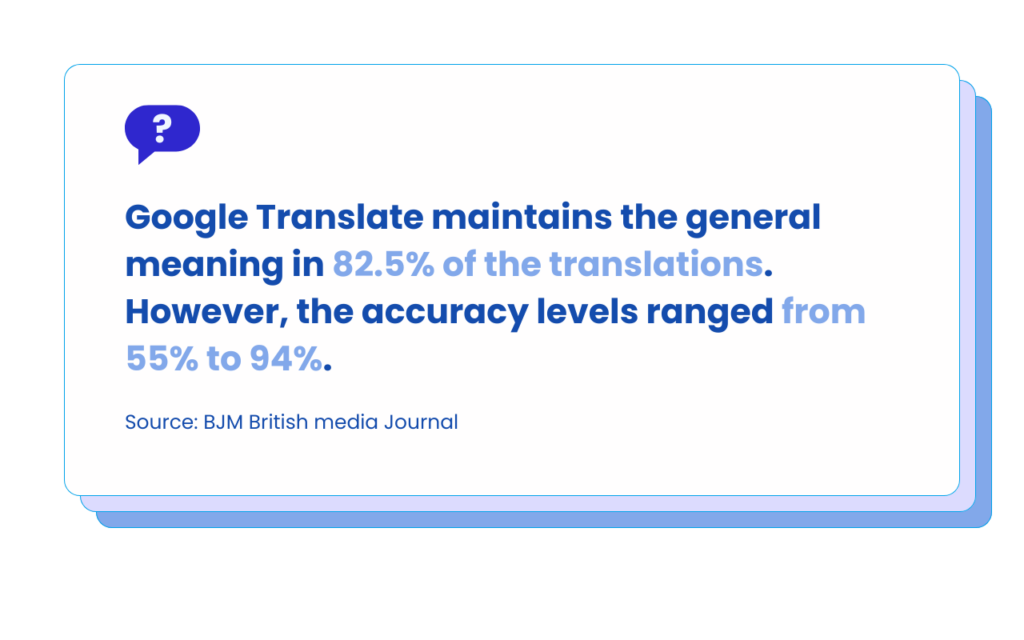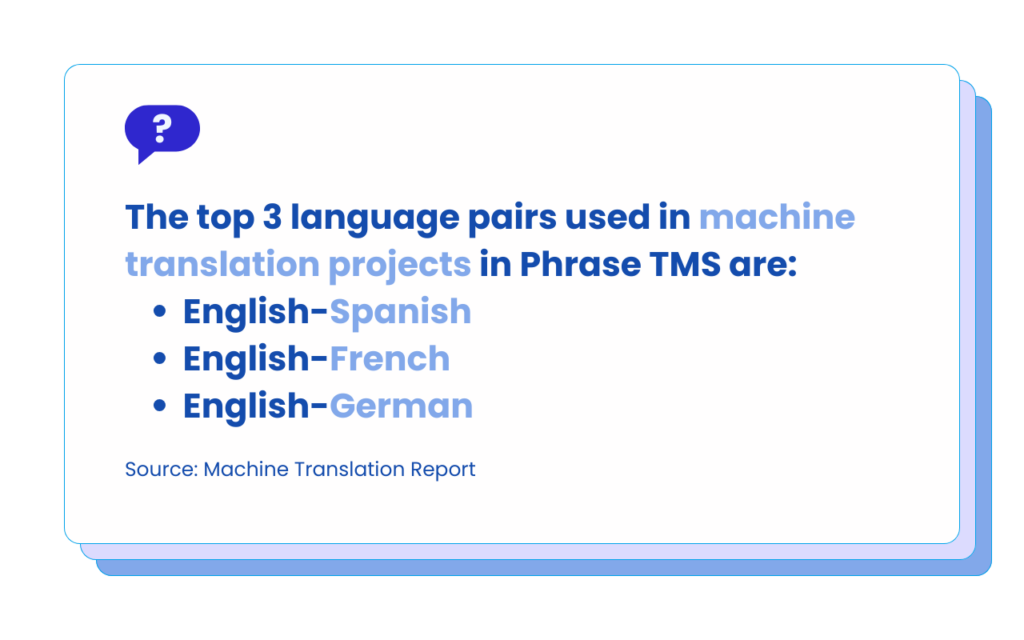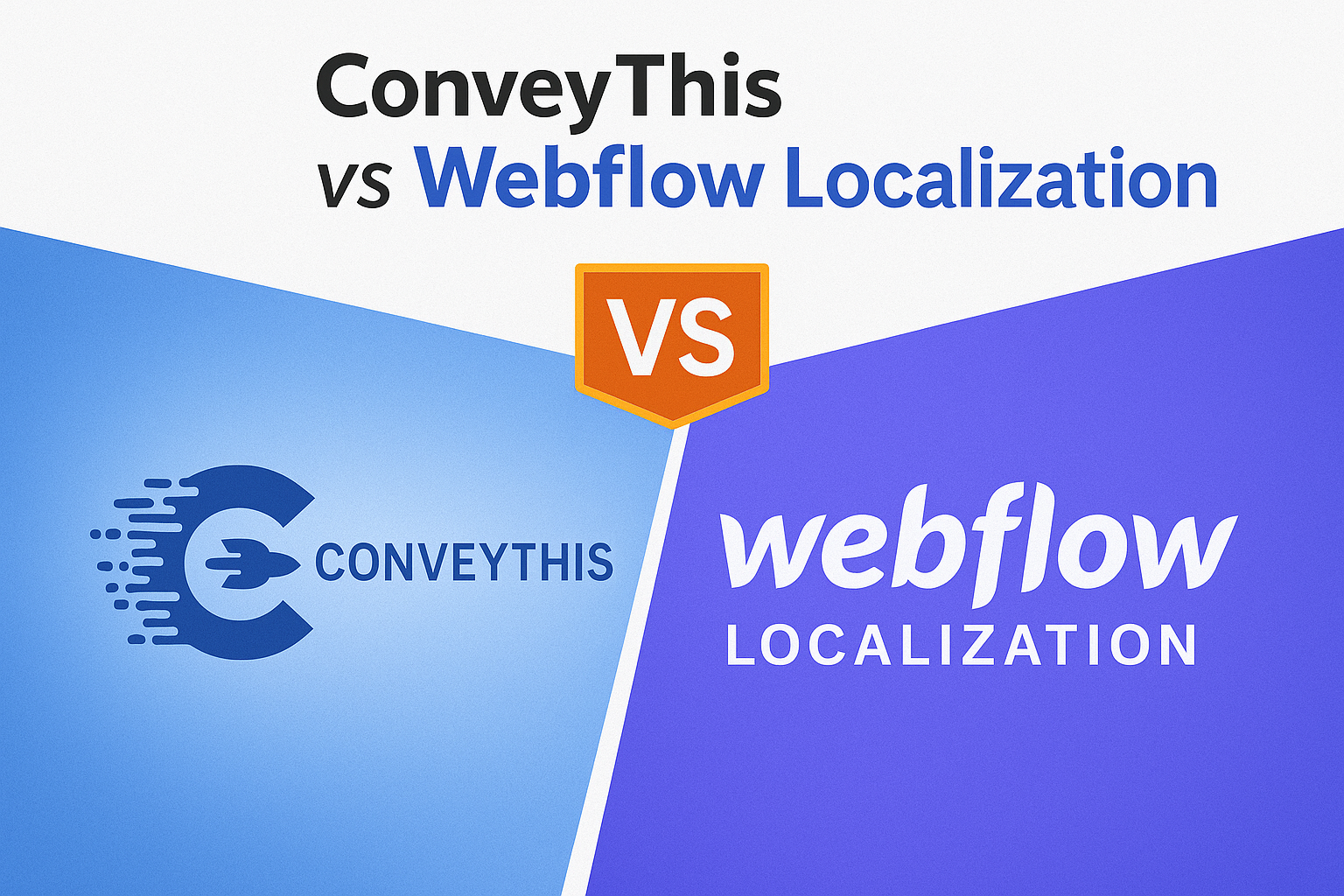How Accurate is Google Translate?
How Accurate is Google Translate? A Comprehensive Exploration of Its Capabilities, Limitations, and Business Use
In today’s globalized world, the demand for fast and accessible translation solutions has reached unprecedented levels. Google Translate, the world’s most widely used free translation tool, plays a central role in this movement by providing translations for over 100 human languages. However, for professional or business use, one critical question remains: How accurate is Google Translate? Does it offer the precision required for high-stakes scenarios where translation errors could have serious consequences?
In this article, we’ll explore the nuances of Google Translate accuracy, assess its reliability for businesses, compare it with other translation platforms like DeepL, Amazon Translate, and Microsoft Translator, and discuss when to choose machine translation over human translation. Whether you’re a small business owner or a website manager, understanding Google Translate’s strengths and limitations can help you make informed decisions for your website localization, multilingual website setup, and communication with native speakers of your preferred language.
The Evolution of Google Translate : From Statistical Models to Neural Networks
Launched in 2006, Google Translate originally utilized a technique known as statistical machine translation (SMT). SMT relies on probabilistic models built from vast datasets, enabling the system to translate words and phrases based on the likelihood of certain combinations. While this approach provided some functional translations, the results were often clunky, overly literal, and prone to translation errors. Sentences could be awkward, nonsensical, or inaccurate due to a lack of contextual understanding, making SMT a far-from-perfect tool for serious translation needs.
The Google Translation Hub took a major step forward in 2016 with the introduction of neural machine translation (NMT). This technology powers the Google Neural Machine Translation (GNMT) system, which analyzes entire sentences rather than breaking them down word by word. This allows it to capture broader meanings, context, and sentence structures, improving the natural flow and overall translation process. GNMT leverages deep learning algorithms to provide more fluent and contextually relevant translations, reducing the translation errors common in earlier versions.
Despite these advancements, users must ask whether Google Translate is accurate enough for professional settings, where the consequences of translation errors can be severe. Is it suitable for translating legal documents, business agreements, or industry-specific content? And how does it compare to more specialized tools like DeepL, Amazon Translate, or Microsoft Translator?
Understanding Its Key Factors In Accuracy?
Several factors contribute to the accuracy of Google Translate, and it’s important to understand these when considering the tool for your business needs. The target language, the source language, the complexity of the content, and the context in which the translation will be used are all significant considerations. When speech translation or Neglish translation (translation with non-native English speakers) is involved, further nuances can impact accuracy.
- Language Pair and Dataset Quality
The accuracy of Google Translate largely depends on the language pair in question. For widely spoken language pairs—such as English to Spanish, French to German, or English to Chinese—Google Translate performs relatively well. This is because Google’s search engine processes large datasets for these language combinations, allowing the algorithm to become more refined and accurate over time. In the Translation Hub, which acts as a central resource for translation processes, these language pairs benefit from rich data sources, leading to higher accuracy.
However, for less commonly spoken or translated languages like Zulu, Haitian Creole, or Uzbek, accuracy can drop significantly. These languages often lack the robust datasets that more widely spoken languages benefit from, leading to translation errors that may misinterpret context, syntax, or idiomatic expressions. This discrepancy in accuracy across language pairs is one of Google Translate’s most significant limitations.
- Contextual Understanding and Complex Sentences
Another crucial factor influencing the accuracy of Google Translate is the complexity of the text being translated. Simple sentences or common phrases are more likely to be translated correctly, but Google Translate can struggle with complex, nuanced language. Sentences with multiple clauses, idiomatic expressions, or industry-specific jargon (e.g., legal, medical, or technical content) often challenge machine translation algorithms, even within the most advanced translation platforms.
This lack of precision is particularly problematic when translating highly contextual documents, such as legal agreements or marketing materials, where native speakers of the foreign language might perceive mistranslations as awkward or unprofessional. While Google Translate has improved in handling these challenges with time, it still falls short of the accuracy provided by native speakers or professional human translators. For instance, in industries where translation memory (the ability to remember previously translated content) is key, Google Translate may not offer the same level of refinement and consistency as a dedicated translation hub would.
- Cultural Nuance and Tone
Machine translation tools, including Google Translate, often fail to capture the cultural nuance of a language. Cultural context is vital for accurate communication, especially when translating marketing content, legal documents, or formal business correspondence. While Google Translate can quickly convert the literal meaning of a text, it may struggle to convey the intended tone or formality required by native speakers in specific cultures, leading to awkward phrasing or inappropriate translations.
For businesses that prioritize tone and formality—particularly in high-context languages like Japanese or Arabic—these limitations are critical to consider. In these cases, machine translation may create more problems than it solves, and the accuracy required for specific target languages may be better achieved through native language expertise. This is particularly important when speech translation or Neglish translation comes into play, as subtle misinterpretations of human languages can lead to significant misunderstandings.
Google Translate vs. Human Translation: Who Wins in Accuracy?
Despite significant improvements in machine translation, human translators continue to have a substantial edge in accuracy, cultural nuance, and fluency. This advantage is especially noticeable in high-stakes applications, such as business communications, legal documents, or technical manuals.
- Why Human Translators Excel
Human translators excel at interpreting the subtleties of human languages—something that Google Translate and other machine translation tools still struggle with. A professional translator not only understands the literal meaning of the text but also its tone, intent, and cultural significance. For instance, a human translator working on legal documents can ensure the translation adheres to specific legal frameworks in both the source language and the target language. This attention to detail ensures the document’s integrity and minimizes the risk of translation errors that could lead to misunderstandings or legal issues.
Furthermore, human translators often make use of translation memory, a valuable tool for businesses that need consistent translations across similar types of content. This allows for faster, more accurate translations in repeated tasks—a capability that Google Translate lacks.
- When Google Translate Is Sufficient
However, there are scenarios where Google Translate can be highly effective. In less formal or time-sensitive contexts, such as searching for quick translations of emails, social media posts, or product descriptions, Google Translate can be a useful tool. The stakes for accuracy are lower in these cases, and a rough translation is often sufficient. Businesses can also use Google Translate to quickly convert customer inquiries or reviews, making it easier to respond to foreign language communications on the fly. In these cases, Google Translate serves as a valuable supplementary tool for basic translations on a translation platform.
Google Translate for Business: Is It Reliable?
For businesses, the question of reliability is essential, especially when it comes to critical content like website localization, legal contracts, or marketing materials. Translation errors in these contexts can result in significant misunderstandings, potential legal issues, and damage to a company’s brand reputation. So, is Google Translate reliable enough for professional use?
- Pros for Business Use:
- Free and Easy to Use: Google Translate is a cost-effective solution for businesses with limited budgets. It allows businesses to quickly translate websites and marketing materials without the expense of professional translation services. For search engine optimization (SEO) purposes, it can also help businesses optimize for foreign markets by generating translations of web content in multiple languages, reaching a wider audience.
- Rapid Translations for Consumer Communications: In scenarios where time is of the essence, such as responding to customer inquiries in a foreign language, Google Translate offers a quick and effective solution. This can be especially helpful for businesses that engage with international customers across various devices and platforms.
- Extensive Language Support: With translations available in over 100 human languages, Google Translate offers one of the most comprehensive translation tools, making it ideal for businesses that serve global markets or have customers from diverse linguistic backgrounds.
- Cons for Business Use:
- Inconsistent Accuracy Across Languages: As mentioned earlier, Google Translate does not perform equally well with all language pairs. Businesses that require translations in niche markets or less commonly spoken languages may encounter inconsistent results, which could lead to translation errors that harm their credibility with native speakers.
- Industry-Specific Vocabulary Challenges: While Google Translate can handle general language fairly well, it struggles with the specialized vocabulary used in fields like medicine, law, or engineering. Mistranslating technical terms could have serious consequences for businesses that rely on precise language to communicate with clients or partners. In such cases, using a dedicated translation hub with translation memory may prove more reliable.
- Limitations in Tone and Formality: Unlike human translators or more sophisticated tools like DeepL or ConveyThis, Google Translate cannot always capture the appropriate tone or formality, which is essential in business contexts. For instance, a translation intended for a high-level executive or a legal document may require a level of sophistication and nuance that Google Translate cannot provide.
Google Translate vs. Other Translation Tools
For businesses considering machine translation as part of their strategy, it’s important to explore alternatives to Google Translate. Here’s a look at how it stacks up against some of the other popular translation tools on the market.
- DeepL vs Google Translate
DeepL, a machine translation tool that also uses neural machine translation, has gained recognition for its accuracy, particularly with European languages. Users frequently report that DeepL provides translations with a more natural flow and better handling of context than Google Translate, particularly for complex sentences.
- Strengths of DeepL: DeepL often excels in handling idiomatic expressions, which makes it a preferred choice for nuanced content. Its translations generally sound more human-like.
- Limitations of DeepL: DeepL’s language coverage is more limited compared to Google Translate, which could be a drawback for businesses needing translations beyond the primary European languages.
- Amazon Translate vs Google Translate
Amazon Translate is a neural machine translation service provided by Amazon Web Services (AWS). It offers scalable translation solutions for businesses and integrates well with AWS’s other cloud services.
- Strengths of Amazon Translate: Amazon Translate provides highly scalable translation capabilities, making it ideal for companies that need to process a large volume of translations. Its integration with AWS services also makes it easier for developers to incorporate translations directly into their applications.
- Limitations of Amazon Translate: Amazon Translate is primarily designed for general-purpose translations and may not offer the same level of customization or post-editing options as tools like ConveyThis. Also, while it performs well with certain languages, Google Translate’s language support is broader.
- Microsoft Translator vs Google Translate
Microsoft Translator is Microsoft’s translation tool, which also uses NMT and supports a variety of languages. Like Google Translate, it is widely accessible and free to use.
- Strengths of Microsoft Translator: Microsoft Translator offers reliable translations for a wide range of languages and integrates with other Microsoft products, such as Microsoft Office, making it convenient for users in business environments. It also provides an API for developers.
- Limitations of Microsoft Translator: While Microsoft Translator performs well in many cases, it is similar to Google Translate in terms of limitations with industry-specific language and context. Its accuracy may vary based on language pairs and complex phrases.
- ConveyThis Translation Tool
ConveyThis combines machine translation with options for human post-editing, providing a blend of speed and accuracy that Google Translate cannot offer. With ConveyThis, businesses can automatically translate their websites into multiple languages and then review or adjust translations for cultural and contextual accuracy. This approach makes ConveyThis ideal for brands that want to ensure a polished, professional look for their multilingual sites.
- Strengths of ConveyThis: ConveyThis offers built-in quality assurance options, allowing businesses to manually adjust or edit translations for precise language use and brand tone. It also supports over 90 languages, making it accessible for most markets.
- Limitations of ConveyThis: As a premium tool, ConveyThis comes with a cost, which may be a consideration for very small businesses. However, for companies looking to make a strong impression with translation accuracy for business, it’s worth the investment.
Best Use Cases for Google Translate in Business
Google Translate is a powerful tool, but like any technology, it has its ideal use cases and limitations. Understanding where it fits within a business context can help you make more informed decisions about when to rely on it and when to seek out professional services.
- Quick Consumer Translations
For low-stakes consumer communications, such as responding to a customer service inquiry or translating product descriptions, Google Translate can be an efficient time-saver. While it may not produce perfectly accurate translations, it often provides sufficient quality for these purposes. Businesses can also use Google Translate to rapidly translate social media posts or basic email correspondence, particularly when engaging with customers in multiple languages.
- Internal Communications
When it comes to non-critical internal documents, memos, or emails between team members who speak different languages, Google Translate can be an invaluable tool. It enables employees to communicate efficiently in a multilingual environment without the need for professional translation services. This can be particularly helpful for businesses with global teams that need to share information quickly and without the need for high levels of formality or precision.
- Preliminary Translations
Many businesses use Google Translate as a starting point for translations, especially when dealing with large amounts of content. For example, a business might use Google Translate to generate a rough draft of a document or a website’s content before passing it along to a professional translator for refinement. This approach allows businesses to save time and resources, while still ensuring that the final product is polished and accurate.
- Early-Stage Website Localization
Google Translate’s vast language support makes it a useful tool for businesses in the early stages of website localization. It can quickly translate an entire website into multiple languages, helping businesses to reach new markets. However, it’s important to note that this should be viewed as a temporary solution. For businesses that plan to engage with international audiences in the long term, investing in professional localization services is a must. These services ensure that translations are not only accurate but also culturally relevant, helping to build trust and credibility with foreign customers.
Google Translate’s Strengths in Language Support
One of the most significant strengths of Google Translate is its extensive language coverage. As of now, Google Translate supports over 100 languages, making it one of the most comprehensive free translation tools available. This wide language support gives businesses access to a global audience and can be particularly valuable for businesses that operate in multiple regions or serve diverse customer bases.
For businesses expanding into new markets, particularly in regions where less common languages are spoken, Google Translate can be an excellent tool for initial communication. However, businesses must remain aware of the varying quality of translations, especially for less widely spoken languages. While Google Translate can help bridge the gap, relying on it for critical communications in these regions can pose risks due to potential inaccuracies.
AI Translation Technology and the Future of Google Translate
The future of AI translation technology looks promising, and Google continues to invest in advancing its capabilities. Google’s ongoing research in neural machine translation, artificial intelligence, and machine learning means that the platform’s accuracy and fluency will likely continue to improve. We can expect future versions of Google Translate to offer even more context-aware and human-like translations.
One area where we are likely to see improvements is in Google Translate’s ability to handle complex sentences and nuanced language. As AI continues to evolve, translation algorithms will become better at understanding idiomatic expressions, cultural references, and industry-specific jargon. Additionally, advancements in AI may lead to greater customization options for businesses, allowing for more precise control over tone, formality, and contextual relevance.
Google is also likely to expand its language support further, helping to bridge the gap for underserved languages. For businesses targeting emerging markets, this could prove to be a significant advantage, as access to high-quality translations in previously unsupported languages will become more accessible.
That being said, the role of human translators is unlikely to diminish entirely. Even as AI translation technology improves, the need for cultural understanding, nuance, and context remains critical, particularly in high-stakes applications like legal documents, medical translations, and branding. Machine translation tools like Google Translate will continue to serve as valuable supplements to human translation, rather than full replacements.
Finding the Right Translation Solution for Your Business
Choosing the right translation solution for your business depends on several factors, including the type of content you need to translate, your target audience, and your budget. While Google Translate offers an accessible, fast, and free translation solution, it has clear limitations when it comes to accuracy, context, and cultural relevance.
For businesses with tight budgets and less formal translation needs, Google Translate can serve as a useful tool for quick translations and internal communications. However, for businesses that require a high level of accuracy, brand consistency, and contextual relevance—such as those involved in website localization, legal translation, or marketing—investing in professional translation services or specialized tools like DeepL or ConveyThis is the smarter choice.
Each tool has its place in the translation ecosystem, and understanding when to use each one is key to optimizing your business’s multilingual strategy. For example, Google Translate may be sufficient for translating social media posts, but when it comes to translating a website’s legal disclaimers or product warranties, a more professional solution is necessary.
Businesses should also consider a hybrid approach, combining the speed and scalability of machine translation with the precision and cultural sensitivity of human translators. This approach ensures that businesses can meet the demands of an increasingly global marketplace while maintaining the high-quality communication that customers expect.
Conclusion: Google Translate in the Modern Business Landscape
In conclusion, Google Translate remains a valuable tool for businesses and individuals seeking quick, accessible translations. Its extensive language support, ease of use, and ability to handle large amounts of text make it an attractive option for businesses that need to communicate with a global audience.
However, when it comes to professional or high-stakes content—such as legal documents, marketing materials, or website localization—Google Translate falls short of the precision and nuance required. For businesses that prioritize accuracy, brand tone, and cultural sensitivity, professional translation services or specialized machine translation tools like DeepL, Amazon Translate, or ConveyThis are better options.
As AI translation technology continues to advance, Google Translate’s capabilities will likely improve, making it even more useful for businesses in the future. Nevertheless, machine translation should be viewed as a supplement to human translation rather than a replacement. By combining the strengths of both machine and human translators, businesses can ensure that their communications are accurate, culturally appropriate, and effective in reaching global audiences.
In the end, the key to successful translation in business is understanding the unique requirements of your content, audience, and goals. With the right approach, businesses can leverage translation technology to break down language barriers, expand their reach, and thrive in the global marketplace.
Additional Resources:
- ConveyThis Integrations to explore compatibility with Shopify.
- How to Translate Shopify Checkout Page for more guidance.
- Help Guide for Translation Your Shopify Email Notifications for step-by-step support.
Translation, far more than just knowing languages, is a complex process.
By following our tips and using ConveyThis, your translated pages will resonate with your audience, feeling native to the target language.
While it demands effort, the result is rewarding. If you’re translating a website, ConveyThis can save you hours with automated machine translation.
Try ConveyThis free for 3 days!
 No card details
No card details






